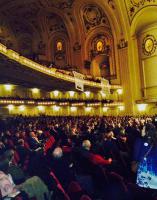In St. Louis (USA) haben sich einige Menschen zusammengefunden, um in Anbetracht der rassistischen Zustände und des Mordes an Mike Brown dorthin zu gehen, wo reiche Weiße einen "Safe Space" für sich beanspruchen: die Symphonie. Sie unterbrachen das Konzert, indem sie aufstanden und im Chor "Gerechtigkeit für Mike Brown" und "Schwarze leben zählen" sangen. Die Aktion begann damit, dass ein schwarzer junger Mann - ins Feindbild der Polizei und des Rassismus passend - aufstand und sang: "Auf welcher Seite stehst du mein Freund, auf welcher Seite stehst du?" Daraufhin stimmten weiße Unterstützer_innen mit ein. Im Publikum sowie unter den Musiker_innen gab es teils Beifall, teils blankes Entsetzen. Ein Moment, in dem klarer wird, wo die Grenzen verlaufen.
Eine nähere Berichterstattung in Englisch sowie ein Video der Aktion, folgend.
https://www.youtube.com/watch?v=T_7ErkQFduQ#t=52
Just after intermission, about 50 people disrupted the St. Louis
Symphony’s performance of Brahms Requiem on Saturday night, singing
“Justice for Mike Brown.”
As symphony conductor Markus Stenz stepped
to the podium to begin the second act of German Requiem, one middle-aged
African-American man stood up in the middle of the theater and sang,
“What side are you on friend, what side are you on?”
In an operatic
voice, another woman located a few rows away stood up and joined him
singing, “Justice for Mike Brown is justice for us all.” Several more
audience members sprinkled throughout the theater and in the balcony
rose up and joined in the singing.
Those in the balcony lowered white
banners about 15 feet long with black spray-painted letters that said, “
Requiem for Mike Brown 1996-2014” and “Racism lives here,” with an
arrow pointed to a picture of the St. Louis Arch. Another banner said,
“Rise up and join the movement.”
Stenz stood stoically and listened
to the demonstrators’ performance. Some onlookers were outraged and
start spewing expletives. Others stood up and started clapping. Most
seemed stunned and simply watched.
The singing only went on for about
two minutes before the demonstrators started chanting, “Black lives
matter.” They pulled up their banners and dropped red paper hearts over
the edge of the balcony onto the main floor orchestra seats, which
stated “Requiem for Mike Brown.” Then they all voluntarily marched out
together and left the theater. While they marched out, they received a
round of applause from many of the audience members – as well as the
musicians on stage.
Outside, symphony administrators huddled together
discussing the demonstration, expressing dismay. When asked if they
wanted to comment, they said no. The demonstrators had purchased tickets
to the concert.
The St. Louis American tracked down and interviewed
the organizer of the event – Sarah Griesbach, 42, a white woman who
lives in the Central West End. She said that the death of Michael Brown,
an unarmed teen who was shot and killed by a police officer in
Ferguson, has opened her eyes to the inequalities that exist in St.
Louis. She has been protesting since Brown was shot on Aug. 9.
“It is
my duty and desire to try to reach out and raise that awareness
peacefully but also to disrupt the blind state of white St. Louis,
particularly among the people who are secure in their blindness,”
Griesbach said.
Two weeks ago, she and another “middle-aged woman who
wear our mom jeans pulled up way too high” held up a sign at a
Cardinals game that said, “Racism lives here.” A pivotal moment for her
was when people around them started chanting in response, “Hands up,
don’t loot.”
She and her fellow protester Elizabeth Vega decided to
try again at the symphony, which received a much warmer response. She
believes that is because the audience was fairly diverse in ethnicity
and age.
“There is an inclusivity that comes with that intellectual culture,” she said.
The
group of demonstrators was also a mix of African Americans, Latino and
white residents – from college kids to college professors, she said.
There were “representatives” from Clayton, Webster Groves, South St.
Louis, Central West End and Ferguson. Although she lives in the Central
West End, her children attend school in Clayton. As a mother, she has
been deeply affected by Brown’s death.
“This cannot be just a Ferguson issue,” she said.
The
St. Louis American got in touch with Erika Ebsworth-Goold, publicist
for the St. Louis Symphony, on Sunday afternoon. She said the musical
piece that the demonstrators chose was appropriate because it is meant
to “lift up the people who were left in time of tragedy.”
She did not feel the group interrupted the performance but “delayed” it, she said.
“The people audience had respect for what we were do at the symphony, and we are appreciative of that,” she said.
Organizer Elizabeth Vega said the group prefers to call it a “disruption,” rather than a delay.
“Many
of us are artists ourselves, so we were very cognizant to not interrupt
the performance after it had already began,” Vega said. “But we still
wanted it to be a disruption that left people with a seed of thought.”

